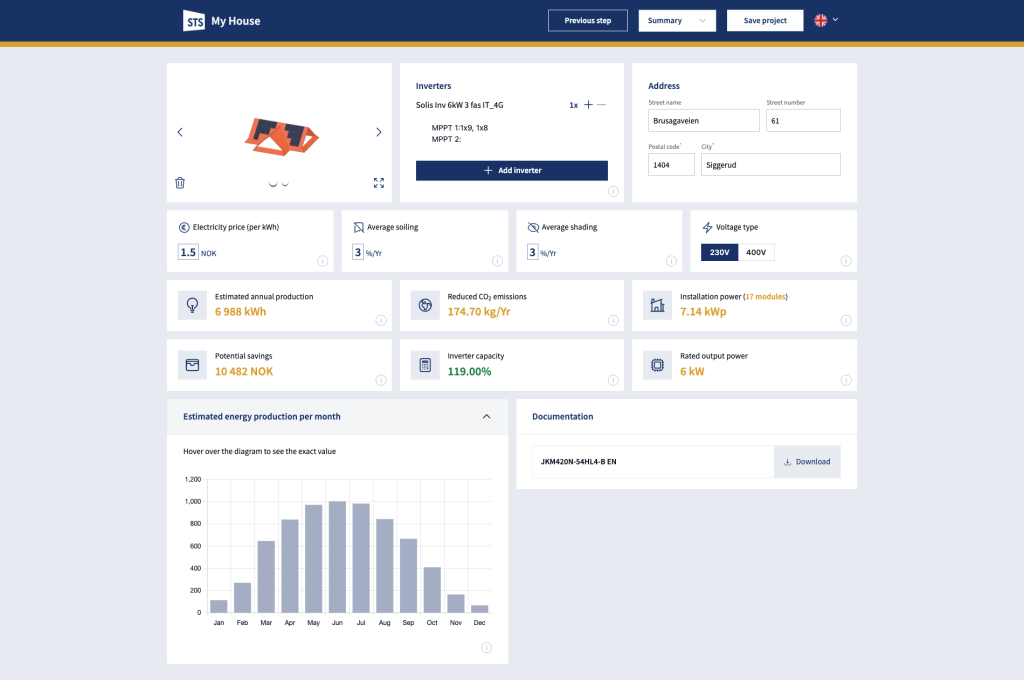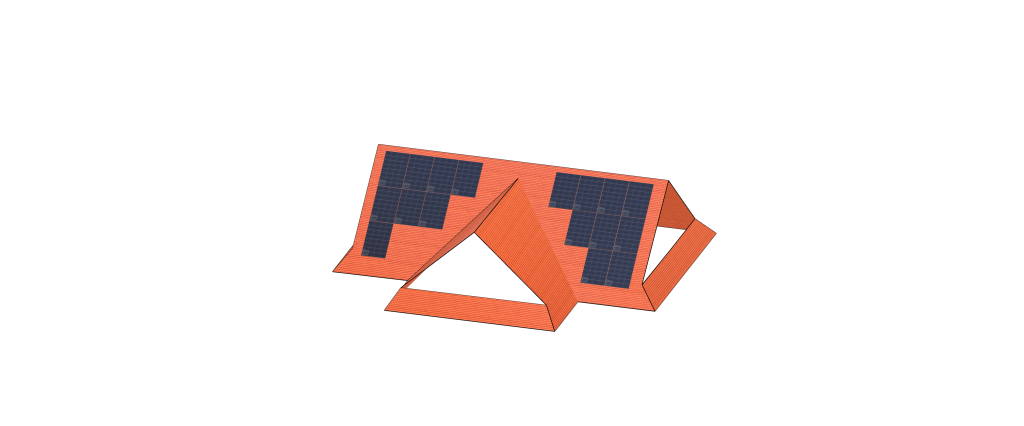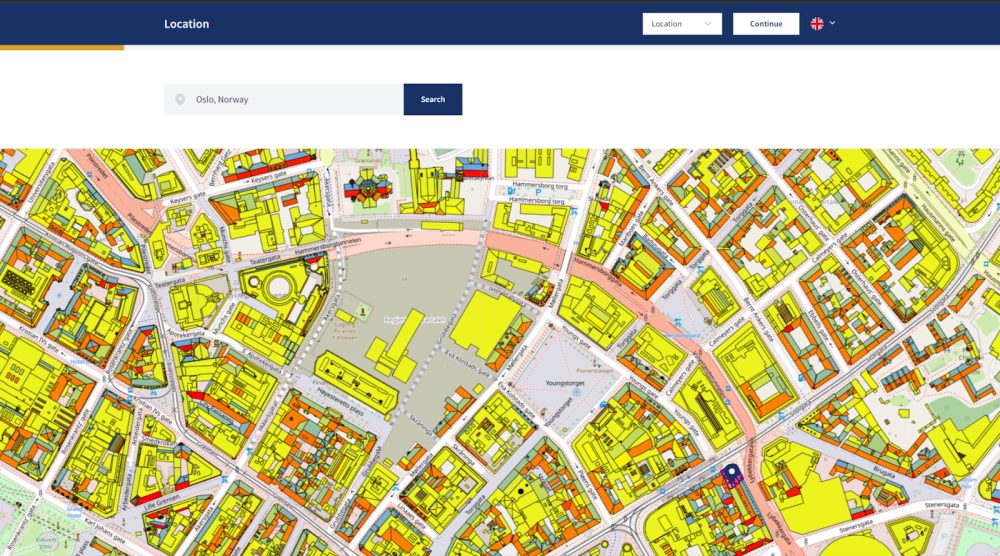GMI Software for Solarts: Revolutionary 3D Solutions and Configurator for the Solar Industry
Our project is revolutionizing the photovoltaic industry by combining a configurator with 3D modeling. It enables rapid customization of solar panels, offering visualizations of installations in a 3D environment. Technical support and detailed installation specifications significantly reduce installation time, increasing efficiency. All of this eases the transition to solar energy, increasing the availability and efficiency of the technology, supporting a sustainable energy future.
Table of content
Table of Contents
Our project is revolutionizing the photovoltaic industry by combining a configurator with 3D modeling. It enables rapid customization of solar panels, offering visualizations of installations in a 3D environment. Technical support and detailed installation specifications significantly reduce installation time, increasing efficiency. All of this eases the transition to solar energy, increasing the availability and efficiency of the technology, supporting a sustainable energy future.
At the heart of their innovative approach is Solarts, an advanced software solution that simplifies the complex process of solar panel installation. Traditionally, deciding on the correct photovoltaic panels, determining their optimal placement, and selecting a suitable installer were tasks that required time, expertise, and a certain degree of trial and error. Solarts turned these challenges into a streamlined, user-friendly experience.
The Solarts project aimed to empower customers with the tools to get a quick quote for the purchase and installation of photovoltaic panels. Users simply enter their address to receive a preview of their roof design, onto which they can virtually place the panels. This 2D and 3D visualization, combined with the software’s ability to suggest an optimal setup based on environmental factors and available products, was a game changer in the photovoltaic industry.
The technology behind Solarts is the result of a fruitful collaboration between Solar Technologies Scandinavia AS and GMI Software.
In this case study, we show how applying our technological skills helped turn Solarts’ idea into a working application. We focused on the practical application of our solutions in software, which brought real changes in customer service in the photovoltaic industry.
Identifying the Needs
In the context of renewable energy, it is crucial to understand and address the specific needs of all parties involved. For Solarts, as a manufacturer of photovoltaic panels, it was paramount to create a product that is not only efficient and reliable, but also easy to install and operate.
Panel installers are looking for solutions that allow them to install quickly and easily, minimizing the risk of errors and ensuring high customer satisfaction. On the other hand, end users, i.e. homeowners and businesses, expect a transparent purchase and installation process, easy access to product information, and confidence that their investment in photovoltaics will bring the expected benefits, both financially and environmentally.
The conventional process of buying and installing photovoltaic panels was cumbersome and time-consuming. It took up to 10 weeks to search for the right panels, review quotes from various installers and choose the right mounting system. This was a significant pain point for both Solarts and end users. There was an urgent need for a digital solution that would clean up the process, increase overall efficiency and significantly reduce turnaround time.
It was clear that a radical change was needed to bring solar technology to a wider audience.
The lack of an effective visualization tool meant that customers faced uncertainty during the purchase process. The ability to virtually see what the solar panels would look like on their roof before making a purchase became a key need. Customers were looking for a tool that would allow them to ‘see’ the future of their solar-powered homes.
Realizing this need led to the development of a system capable of providing a realistic 2D and 3D representation of the layout of solar panels on specific buildings.
Tailored Recommendation System
Buying photovoltaic panels is not only about choosing the most attractive models, but more importantly, selecting the right panels and mounting system, taking into account various environmental factors such as the building’s insolation and snow load. This process required technical knowledge that customers often lacked, leading to inappropriate or suboptimal choices. Hence the need for an intelligent recommendation system that would take these variables into account and automatically suggest the optimal panels and mounting system.
Connecting with a Good Installer
Another challenge for customers was finding a reliable and experienced installer in their area. The quality of the installation is as important as the quality of the panels themselves, and the lack of a reliable platform to connect customers to a network of trusted professionals was a major problem.
This pain point underscored the need for a comprehensive platform that provided a seamless process from panel selection to installation. Additionally, the end customer can now easily see how much energy and money they can save, making it easier to make informed decisions.
GMI Software Team
The following people played key roles in the GMI Software project:
- CTO/PO: Project management, linking technology to business goals.
- UI/UX Designer: Creating intuitive user interfaces, improving customer engagement.
- Full Stack Developer: Integrate front-end and back-end, build software architecture.
- Backend Developer: Working on server logic and databases, ensuring system performance.
- Frontend Developer: Transforming UI/UX designs into a functional application, giving it its final shape.
- 3D Developer: Create realistic 3D models, enable visualization of solar installations.
Project Backlog and Design Stage
In the vast ocean of software development, navigating through complex project requirements and translating them into tangible solutions is a daunting task. For the Solarts project, the lighthouse guiding this voyage was established during the Discovery and Design Stage. This crucial phase embodied the soul of the project, setting the compass for the development journey.
The initial step in this monumental undertaking involved crafting a detailed map of the customer journey. Understanding the numerous touchpoints of a customer’s interaction with Solarts, from the initiation of the process to the final stages, was essential. By empathizing with the customer’s needs, desires, and pain points, the team was able to weave a user-centric narrative. This careful study of user behavior and patterns served as the backbone for optimizing user experience, engagement, and ultimately, the success of Solarts.
Product Backlog
The heart of the project was its meticulously curated product backlog. This prioritized inventory of features, functionalities, and improvements formed the crux of the developmental blueprint. An ever-evolving guide, the backlog dictated the direction of the developmental wind, aligning team efforts towards the next key deliverable. It served as the lighthouse, constantly guiding the team through the turbulent waters of the development process.
Navigating 3D Space
One of the pivotal challenges was the creation of accurate 3D models of Norwegian buildings, essential for precise photovoltaic panel installation simulations. The task required interfacing with an API that could return the requisite file format. This data was then programmatically converted into a 3D model and integrated into BabylonJS, a powerful 3D rendering engine.
Accomplishing this required complex data transformations to reflect precise roof dimensions and slope. Leveraging Node.js and Nestjs, server-side JavaScript run-time and progressive Node.js frameworks respectively, the team was able to perform intricate calculations and data transformations required for the 3D model conversion process. This led to the creation of a system that reliably transformed real-world architectural data into interactive 3D visualizations.
Optimal Panel and Mounting System
Developing a robust, intelligent system for panel placement recommendation required a significant amount of computational logic. By leveraging React and Next.js, renowned for their efficiency and performance in building dynamic user interfaces, an algorithm was developed that suggested the optimal number of panels and their placement, factoring in various physical constraints such as chimneys, ladders, and skylights.
The recommendation system was further extended to suggest an optimal mounting system. This demanded the integration of a multitude of variables, including the number of fixings, mounting rails, and the local snow load. Node.js and Nestjs were once again employed to devise and implement this complex backend logic. The result was a system that recommended the most suitable mounting system to users, ensuring long-term panel stability and maximum energy production.

Recommendations and Management
The GMI Software team developed a system to recommend the best placement of photovoltaic panels, using React and Next.js to take into account constraints such as chimneys. We extended this system to include mounting system recommendations, analyzing various variables using Node.js and Nestjs to help users choose the most stable and efficient mounting solutions. With MySQL, we also created a product management module that ensures that virtual panels are compatible with real products, offering realistic 3D visualizations
Results
The development and implementation of Solarts has significantly impacted the photovoltaic industry, speeding up and streamlining solar panel installations. A key achievement has been the reduction of the time required to quote for solar panel installations from 10 weeks to just two days, a fivefold increase in efficiency.
Solarts, by offering intelligent recommendation systems and realistic 3D visualizations, has enabled customers to make informed choices about solar panel installations. The platform allows customers to visualize the location of the panels on their roofs and select the best installer from their immediate area, making the process more transparent and increasing customer satisfaction.


Conclusion
Project Solarts is not only an advancement in solar technology, but also the result of the client’s and our work and passion. By turning an ambitious idea into a reality, we have shortened the process of quoting customer installations from 10 weeks to 2 days, opening the way to sustainable living for many people. What we have achieved with Solarts has significantly raised the standards for the entire industry.
If your company has big ambitions and wants to make a difference, GMI Software can help make those dreams a reality. We believe in innovation and are ready to embark on this journey with you.
Let’s work together to innovate for a brighter and greener future!


